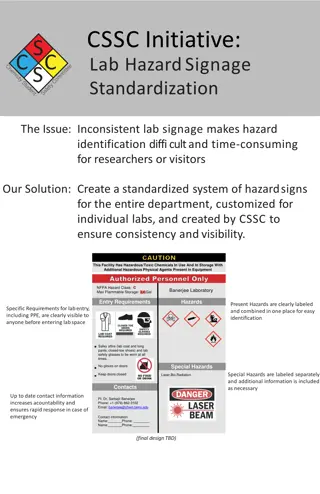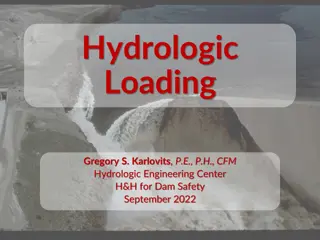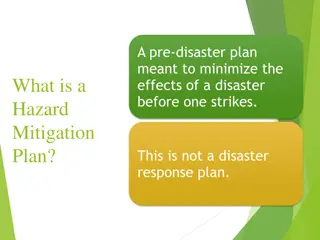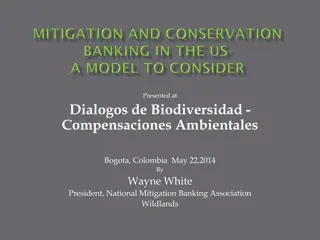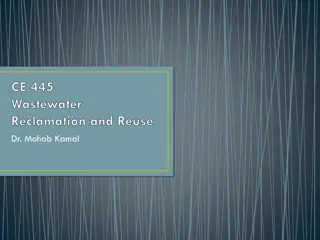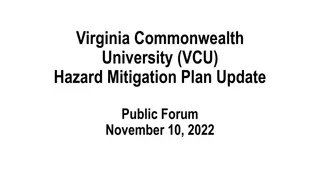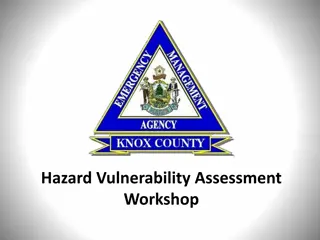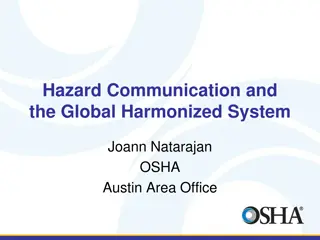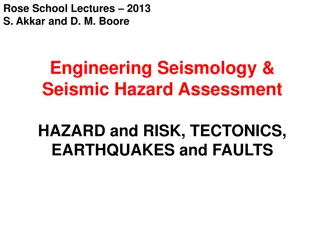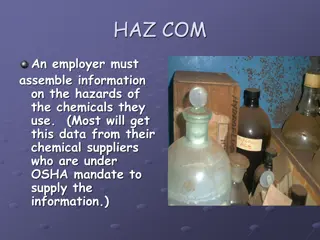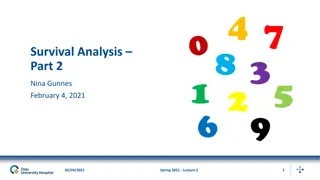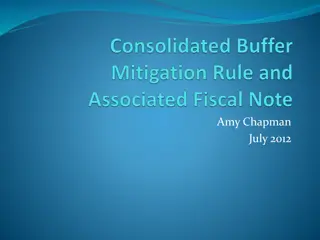Comprehensive Risk Assessment and Hazard Mitigation Planning
This work delves into risk assessment and hazard mitigation planning supported by the National Science Foundation. It covers the importance of hazard identification, risk assessment, and mitigation planning components. Mitigation actions are outlined to reduce risks to life and property, prevent damage, and aid in community recovery. The benefits of mitigation planning are highlighted, emphasizing stakeholder involvement, resource focus, partnership building, and education enhancement.
Download Presentation

Please find below an Image/Link to download the presentation.
The content on the website is provided AS IS for your information and personal use only. It may not be sold, licensed, or shared on other websites without obtaining consent from the author. Download presentation by click this link. If you encounter any issues during the download, it is possible that the publisher has removed the file from their server.
E N D
Presentation Transcript
RISK ASSESSMENT AND HAZARD MITIGATION PLAN an introduction to guide your projects! This work is supported by the National Science Foundation s Directorate for Education and Human Resources (TUES-1245025, IUSE- 1612248, IUSE-1725347). Version: 05 25, 2018 Questions, contact education-AT-unavco.org
RISK ASSESSMENT A hazard identification and risk assessment provides the factual basis for activities proposed in the strategy portion of a hazard mitigation plan. An effective risk assessment informs proposed actions by focusing attention and resources on the greatest risks. In Units 1, 2, and 3, what did we learn/do that would help us focus attention on the greatest risks?
RISK ASSESSMENT Four basic components: 1. Hazard Identification (Unit 1). 2. Profiling of hazard events (Units 1-3). 3. Inventory of assets. 4. Estimation of potential and economic losses based on the exposure and vulnerability of people, buildings, and infrastructure.
HAZARD MITIGATION PLANNING Mitigation - sustained actions taken to reduce or eliminate long- term risk to life and property from hazards. Prevention - actions necessary to avoid, prevent, or stop an imminent threat or actual act of terrorism. Protection - actions necessary to secure the homeland against acts of terrorism and manmade or natural disasters. Preparedness - actions taken to plan, organize, equip, train, and exercise to build and sustain the capabilities necessary to prevent, protect against, mitigate the effects of, respond to, and recover from those threats that pose the greatest risk to the security of the Nation. Response - actions necessary to save lives, protect property and the environment, and meet basic human needs after an incident has occurred. Recovery - actions necessary to assist communities affected by an incident to recover effectively.
HAZARD MITIGATION Mitigation is critical to: Protect public safety and prevent loss of life and injury. Reduce harm to existing and future development. Prevent damage to a community s unique economic, cultural, and environmental assets. Minimize operational downtime and accelerate recovery of government and business after disasters. Reduce costs of disaster response and recovery and the exposure to risk for first responders. Help accomplish other community objectives (leveraging capital improvements, infrastructure protection, open space preservation, and economic resiliency).
BENEFITSOF MITIGATION PLANNING Identifying actions for risk reduction that are agreed upon by stakeholders and the public. Focusing resources on the greatest risks and vulnerabilities. Building partnerships by involving citizens, organizations, and businesses. Increasing education and awareness of threats and hazards, as well as their risks. Communicating priorities to State and Federal officials. Aligning risk reduction with other community objectives.
MITIGATION TASKS Determine the Planning Area and Resources Build the Planning Team Create an Outreach Strategy Review Community Capabilities Conduct a Risk Assessment Develop a Mitigation Strategy Keep the Plan Current Review and Adopt the Plan Create a Safe and Resilient Community
TASK 1: DETERMINETHE PLANNING AREAAND RESOURCES Geographic area covered by the plan? Arizona or Puerto Rico? Usually determined by local government jurisdictional boundaries, but can be defined by natural features. For your groups respective area, select a jurisdictional or natural boundary. The boundary should cover almost the entire area. You do not need to consider resources for this project*
TASK 2: BUILDTHE PLANNING TEAM This is the core group of people responsible for developing and reviewing drafts of the plan, creating the mitigation strategy, and submitting the final plan for local adoption. The planning team (YOUR GROUP) has the expertise to develop the plan. Who is in charge of different components? What are their individual expertise?
PLANNING TEAM USUAL SUSPECTS Emergency Management Fire Department/Districts Parks and Recreation Public Information Office Public Works Stormwater Management Transportation Who else???
TASK 3: CREATEAN OUTREACH STRATEGY A plan that accurately reflects the community s values and priorities is likely to have greater legitimacy and greater success in implementing mitigation actions to reduce risk. Why do you think this is? How could you incorporate this into your report?
TASK 4: REVIEW COMMUNITY CAPABILITIES Describes the step of assessing your community s existing authorities, policies, programs, and resources. Not needed for your groups report.
TASK 5: CONDUCTA RISK ASSESSMENT Planning team determines the potential impacts of hazards to the people, economy, and built and natural environments of the community. Needed for your report: Regional assessment (Unit 2 and 3) Local assessments (Unit 1)
RISK ASSESSMENT TERMINOLOGY Natural hazard source of harm or difficulty created by a meteorological, environmental, or geological event. Community assets the people, structures, facilities, and systems that have value to the community. Vulnerability characteristics of community assets that make them susceptible to damage from a given hazard. Impact the consequences or effects of a hazard on the community and its assets. Risk the potential for damage, loss, or other impacts created by the interaction of natural hazards with community assets. Risk assessment product or process that collects information and assigns values to risks for the purpose of informing priorities, developing or comparing courses of action, and informing decision making. Threat or human-caused incident intentional actions of an adversary, such as a threatened or actual chemical or biological attack or cyber event.
STEPSTO CONDUCTA RISK ASSESSMENT 1. Describe Hazards 2. Identify Community Assets 3. Analyze Risk 4. Summarize Vulnerability
TASK 6: DEVELOPA MITIGATION STRATEGY Serves as the blueprint for reducing the potential losses identified in the risk assessment. Provides suggestions for developing a new or updating an existing mitigation strategy.
TASK 7: KEEPTHE PLAN CURRENT Mitigation plans are living documents. WHY? Recognize this fact, but updates are not necessary/possible for your groups plan.
TASK 8: REVIEWAND ADOPTTHE PLAN Initiate local adoption through review and approval process. Incorporate feedback from the planning team, stakeholders, and the public on the final document. For this project, since actual adoption is not feasible, you will focus on reviewing (EDITING) your document.
TASK 9: CREATEA SAFEAND RESILIENT COMMUNITY What might be some barriers to mitigation? How can mitigation barriers be overcome? Consider these questions, but this task is not required for the final deliverable.
RESOURCES The FEMA Local Hazard Mitigation Handbook is a GREAT resource! Use it! There are many online hazard mitigation plans: Local Hazard Mitigation Plan (2016) for the city of Hayward, CA, USA is a good example of a strong hazard mitigation plan. NOTE: The plan focuses on a variety of hazards, not just landslides. Use it as a guide/example, not as a template.





